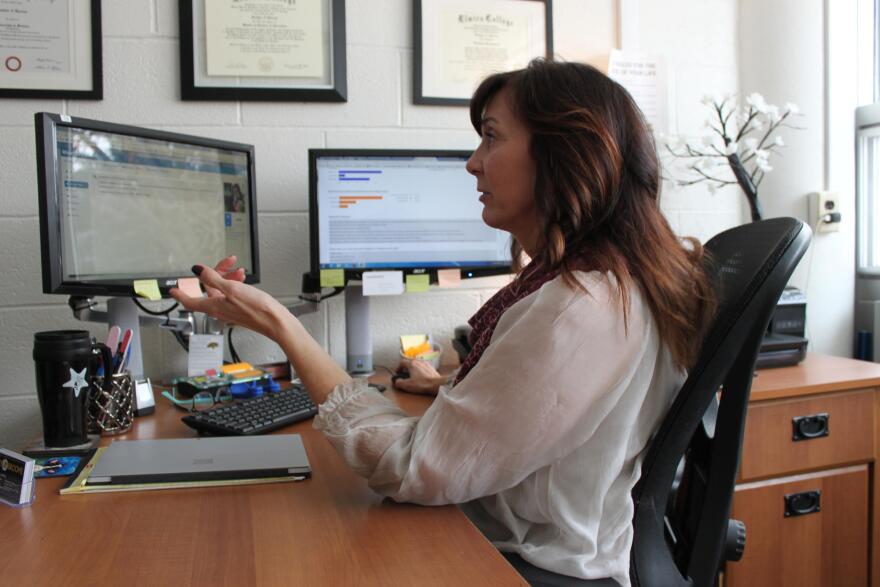Dan White of Apalachin is a freshman at SUNY Broome, near Binghamton. At first, he thought about attending the University of Buffalo, but decided to live at home, save money, and work at a local Subway sandwich shop. Dan admits he thought college would be like a harder version of high school. But it was definitely tougher than that.
"It was just kinda new for me, you know, trying to figure out how to study and all that," he said. "Then all of the sudden in one of my classes, you know, I get an email...and it's just like, 'hey you're doing a really good job!'"
He got an email from a professor through a software program called Starfish. SUNY Broome uses Starfish to keep students on track. Professors can send kudos to students, like Dan's did. And they can also send flags.
"'You know, you're doing good but hey, you're missing this assignment and that assignment. You know you should try to put that in.' And I was like, 'okay, yeah, no problem.' And that would really focus me again," Dan said.
But would he have done the assignment without that reminder? He chuckled at the question.
"Probably not with the grades I got. Probably would have got a lot lower grades."
So Starfish made a difference to Dan's grades. And you can imagine another student just ignoring the message altogether. But nudges like that can make a difference if a student is at risk for dropping out, and SUNY campuses are using "ed-tech" software programs like Starfish to turn more students into graduates.
Heather Darrow works with students at SUNY Broome who are on academic probation. All those kudos and flags that professors send to students also get sent to academic coaches like her.
"On my homepage I can see, of our student population, what students are doing well, what students are struggling and what students are really struggling," she said.
That's the benefit of Starfish - students, professors, and support staff all know what's up with a student's progress - with an eye toward staying in school.
Darrow said retention isn't always about money or academics. When she was in college, she almost dropped out because of events in her personal life. "I had deaths in the family. I had, you know, catastrophic things happen to me in life that have nothing to do with school but really could have deterred me entirely."
She persisted, she said, because caring faculty paid attention to her. A program like Starfish is meant to make that simpler.
But the feature of Starfish - that everyone is on the same page - might also be a bug, if not everyone is contributing. SUNY Broome professor Stephanie Malmberg said she has a love-hate relationship with Starfish, because students might not get the full picture.
"They might be walking through thinking 'oh, I'm doing really well,' but it's only my class they're receiving feedback in, and there's a potential to be bombing two or four other classes," she said. "It's just what an instructor chooses to put in and which instructors choose to put in."
Not all instructors even use the program. Darrow said it's about half. It's hard to know yet if it's making a big dent, because it's new; SUNY Broome started using Starfish early last year.
But SUNY, as a system, is committed. SUNY has a contract for Starfish and other software from the ed-tech firm Hobson's. Altogether, schools in the system will pay Hobson's up to $9.1 million over five years. The firm says 17 public colleges in New York use the program and most of those are community colleges. There are also private schools who use it.
Getting college students to complete their degrees is something SUNY Chancellor Nancy Zimpher talks about a lot. She explicitly connected retention to college loan debt at a New York state Assembly committee hearing late last year.
"We know that helping students finish on time or early is one of the surest ways to diminish student debt. In this case, time is money," she said.
The thinking goes, the sooner students finish school, the less money they'll spend. And if they get a degree and a better job, they can pay their loans.
SUNY may also be responding to a national trend of falling college enrollment. With fewer students coming in the door, keeping the ones you have becomes more important, whether you use Starfish or another retention software.
In that case, SUNY and its colleges might be feeling a lot like freshman Dan White.
"I guess Starfish was like a wakeup call. Just like 'hey, you know, this is college,'" he said. "Get on the train or you're left behind, you know?"







